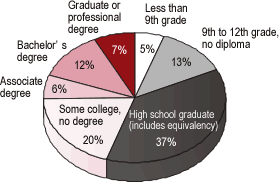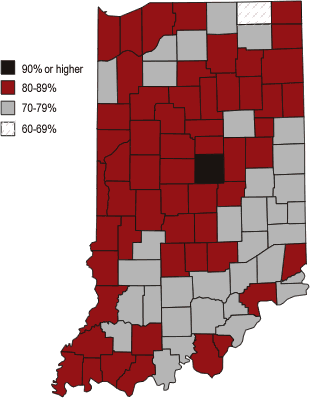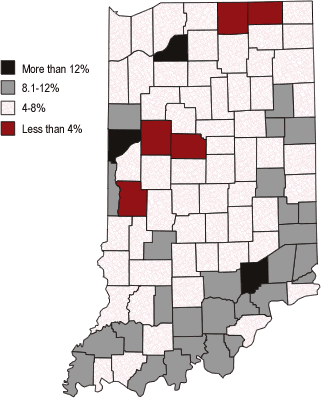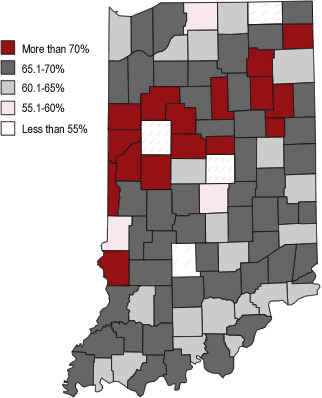Indiana Makes Progress on the Educational Attainment Gap
Indiana Business Research Center, Kelley School of Business, Indiana University
One area of continuing concern for Hoosiers has been the educational attainment of our citizens. Education is regarded as a key to economic development. In the past, Indiana has lagged the nation in attainment of degrees. In addition, great disparities have existed among the counties within our state. As the data from Census 2000 flow in, we can begin to examine these issues.
Degree Attainment 2000
Census 2000 recorded 3.9 million Hoosiers age 25 and older. Of these, 44.9 percent had some formal education beyond the high school level (see Figure 1). Even without a significant junior college system, 6 percent had an associate degree. Despite widespread opportunities for graduate education, only 7 percent had graduate or professional degrees.
Figure 1
Indiana's Educational Attainment, 2000
But 20 percent had taken some post-high school education without attaining a degree. Is this a failing of either the schools or the students? It might not reflect any failure at all. In fact, it might indicate wise career decisions and efficient education systems. Degrees are the creation of academic institutions that are supposed to indicate certain levels of achievement. That contention, however, is subject to dispute. Nonetheless, if rewards are assigned to people willing to accept the discipline and dictates of others, then degrees will be a correlate for income.
Indiana and the U.S.
In 2000, Indiana lagged the nation in educational attainment at all levels above high school completion (see Figure 2). Our citizens tend to achieve that high school diploma but fall short on higher levels of educational attainment.
Figure 2
Educational Attainment, 2000
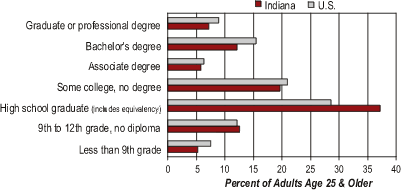
Of course, we cannot say from these data exactly what this means. Since the data available at the time of this writing do not tell us the education level by age, it may be that our older citizens, who did not have extensive opportunities to further their education, are giving a downward twist to the numbers. (Indiana does have a higher percentage of older residents than the nation as a whole.)
Equally important, we do not know if the people of Indiana today were educated in this state or elsewhere. Nor do we know where the individuals educated in Indiana in the past are living today. We may have a higher percentage of high school graduates than the nation because Indiana offers good jobs for people with such a level of education. This would cause Hoosiers with high school degrees to stay here and would also invite those from other states with high school degrees to migrate to Indiana.
If we sum the differences between Indiana's attainment percentages in the four categories above high school, we find 44.9 percent of Hoosiers had some post-secondary education in 2000. Nationally, that percentage was 51.7 percent (see Figure 3). Indiana lagged the nation by 6.8 percent in 2000. The 1990 figures were 37.4 percent for Indiana and 45.2 percent for the U.S., a difference of 7.8 percent. Indiana closed the educational attainment gap by 1 percent of its adult population in the 1990s. Alternatively, while the U.S. advanced by 6.5 percent during the '90s, Indiana moved up by 7.5 percent.
Figure 3
Comparative Educational Attainment: Percent of Adults with Some Post-Secondary
Education
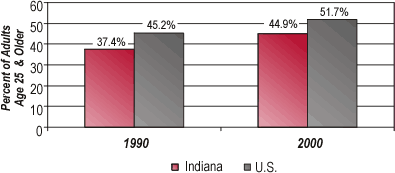
Where did we close the gap in educational attainment? Figure 4 shows the gains made in the U.S. and in Indiana during the 1990s. The Hoosier state did better than the nation, in terms of percentage gains, in all post-secondary levels except for graduate education.
Figure 4
Change in Educational Attainment Percentage During the 1990s

County Level Educational Attainment
While we are interested in the level of educational attainment in each county, we may also seek to discover where the greatest changes have occurred over the past decade. Those changes may be the result of decisions made by continuing residents of the county or the result of in- and out-migration. Or they may be the consequence of older, less educated citizens dying off. At this point, the Census data do not give us any help in understanding the dynamics of the changes we observe.
Figure 5 presents the educational attainment of each county. Hamilton County alone has more than 90 percent of its residents age 25 and older with a high school education. Sullivan is the middle county in the state at 80.8 percent. Lagrange County is the sole county below 70 percent. (Editor's Note: This can probably be explained by the significant Amish population in the county.)
Figure 5
Percent of Adults Age 25 and Older with a High School Degree or Higher, 2000
But there has been a great deal of change in the past decade, as shown in Figure 6. Eleven counties have made gains of 10 percent or more in the percent of their population age 25 and older who have a high school degree or higher. The median county has gained 7.1 percent.
Figure 6
Progress in Educational Attainment: Change in Percent of Adults Age 25 and
Older with a High School Degree or Higher, 1990-2000
Surprisingly, Tippecanoe County made the least progress (2.6 percent). The argument that Tippecanoe had a strong position in 1990 and less room to improve (85.2 percent, second in the state) does not seem appropriate given that number one Hamilton (88.7 percent in 1990) went up 5.5 percent and Monroe County (82.1 percent) advanced by 6.4 percent.
Where is the market for higher education in the state? This can be determined, in part, by subtracting the percent of people with bachelor's degrees or higher from those with high school degrees or higher. Figure 7 gives us those data. In the median county 66.8 percent of the adult population had a high school degree but had not secured a bachelor's degree.
Figure 7
Percent of Adults Age 25 and Older with a High School Degree but Less than
a Bachelor's Degree, 2000
As expected, Hamilton, Monroe, and Tippecanoe counties are already well-educated communities. It is surprising, however, to find Lagrange County in this group of counties seemingly not in need of post-secondary education resources. This result occurs because Lagrange and other counties with low percentages of high school completion would not be ready for post-secondary programs until they raise their high school degree status.
When more detailed data are available from Census 2000, we will be able to determine more definitive answers about the dynamics of changes in educational attainment. But as long as policy makers believe that degrees are a proxy for education, that educational attainment is a variable they can influence, and that it is important to economic development, they will not need to wait for the data.


